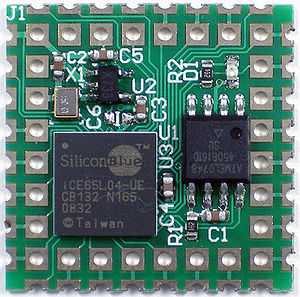SiliconBlue Technologies
| Private | |
| Industry | Integrated Circuits |
| Founded | 2006 |
| Headquarters |
Santa Clara, United States |
Key people | Kapil Shankar (CEO) |
| Products | FPGAs |
| Website | www.siliconbluetech.com |
SiliconBlue Technologies Corporation was a United States based manufacturer of ultra-low power programmable logic devices (FPGAs) that the company calls "mobile FPGAs." The products target mobile and hand-held electronics applications that require low power and small physical size.[1][2] It was acquired by Lattice Semiconductor in 2011.[3]
SiliconBlue iCEcube2 development tools package includes ....[4]
- the Synplicity synthesis technology from Synopsys,
- place and route tools that include timing-driven placement
- static timing analyzer
- graphic floorplanning and I/O assignment tools
- power estimator
- programming software
SiliconBlue's mobileFPGA products are notable because their devices are the lowest power FPGAs to be marketed. In fact, their devices are low power and low cost enough to be used in cell phones. This is a significant advance in FPGA design and will potentially open up new markets to FPGAs where they had not been practical until now.

Technology
The SiliconBlue iCE65 FPGA family is manufacted by TSMC using 65 nm process.[5] The iCE65 FPGAs can be configured similar to other RAM-based FPGAs. Optionally, the FPGA can load its configuration from internal Nonvolatile Configuration Memory (NVCM).
SiliconBlue's FPGA fabric is very common architecture based on a four-input look-up table (LUT4) and flip-flops. The iCE65 fabric includes RAM blocks, each with 4,096 memory bits, arranged as 256 locations, each location 16 bits wide. However the write port has write mask input port what allows any smaller width of memory to be emulated. The iCE65 'P' FPGAs also include an on-chip PLL/DCM; the iCE65 'L' FPGAs do not have a PLL. The only other special primitives are global buffers and warmboot primitive.
Configuration
Like other RAM-based FPGA, SiliconBlue mobileFPGAs are configured immediately after power is applied or upon request. There are multiple methods to configured mobileFPGAs, including ...
- SPI Master, with configuration data stored in an industry-standard SPI Flash,
- SPI Slave, with configuration data downloaded to the mobile FPGA by external microcontroller (MCU), processor (CPU), or digital signal processor (DSP)
- internal NVCM (nonvolatile configuration memory)
- JTAG, which is available only on certain package options
SiliconBlue iCE65 Ultra Low Power FPGA's use Kilopass XPM OTP memory for on-chip secure configuration storage.[6]
On power up one of four configuration images can be selected (coldboot mode), or then at run time reconfiguration can be invoked from the FPGA fabric logic (warmboot). New configuration image can optionally load block RAM's or they can hold old contents.
Kilopass XPM Configuration memory
- No voltage storage so no inductive, IR, or magnetic detection
- No charge storage
- Not visually identifiable like Fuse technologies
- SRAM Devices with Encryption can have the KEY deciphered from the silicon memory technology (EEPROM or FLASH)
- The memory is embedded in the XPM cell → Totally Secure
- Self-Destruct Capability
- Write-locks
The NVCM of the iCE65 family is programmed via SPI slave interface; there is no separate JTAG interface or special algorithm required.
The power consumption is where these devices show their unique characteristics. The largest device in the family, the iCE65L16, is claimed to consume 250-microamps at 32-kHz and 40 milliamps at 32-MHz.[6] The high speed number is well below any competing device on the market and the 32-kHz current is orders of magnitude less than that of other vendors. The expected cost of these devices is also notable. They are targeted to devices that have to be cheap enough to be given away. Silicon Blue has kept that in mind when designing these parts. Using a 65 nm process keeps the die size small to make them very inexpensive.[7] Low standby power consumption and low device cost are required to make FPGAs practical for use in cell phone handsets.
References
- ↑ Morris, Kevin (June 3, 2008). "SiliconBlue Debuts Low-Power FPGAs". FPGA and Structured ASIC Journal. techfocus media. Retrieved 2009-03-25.
- ↑ Maxfield, Clive (June 2, 2008). "The first new FPGA fabric in the last 10 years?". Programmable Logic DesignLine. United Business Media. Retrieved 2009-03-25.
- ↑ "Lattice Semiconductor to Acquire SiliconBlue" (Press release). 2011-12-09. Retrieved 2012-12-03.
- ↑ "Development Tools". Products. United Business Media. June 2, 2008. Retrieved 2009-03-25.
- ↑ Maxfield, Clive (February 9, 2009). "SiliconBlue ships iCE65 ultra-low-power FPGAs in volume". EE ProductCenter. United Business Media. Retrieved 2009-03-29.
- ↑ 6.0 6.1 Clark, Peter (July 3, 2008). "FPGA startup aims at the handset". EETimes. United Business Media LLC. Retrieved 2009-03-25.
- ↑ Morris, Kevin (July 3, 2008). "New Kid in Class". FPGA and Structured ASIC Journal. Techfocus Media, Inc. Retrieved 2009-03-31.
External links
| Wikimedia Commons has media related to SiliconBlue Technologies Corporation. |